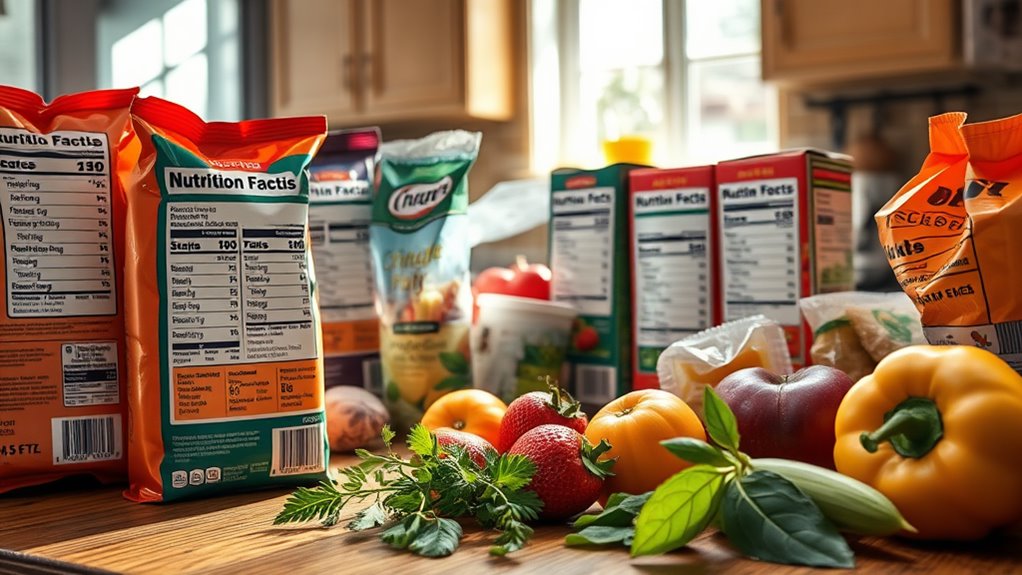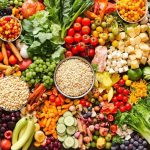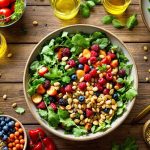
Decoding nutrition labels is essential for maintaining a healthy diet. Start with serving sizes to manage portion control. Use % Daily Value (%DV) to determine if a food is low (5% or less) or high (20% or more) in nutrients. This guides you to pick nutrient-rich options like fiber and potassium. Limit intake of saturated fats, trans fats, and added sugars, monitoring their presence on labels. Remember, each gram of fat provides 9 calories, while carbs and proteins offer 4 each. MyPlate guidance aids in balancing meals. Access the benefits of informed food choices to enhance your health journey.
Understanding Serving Sizes
When diving into the world of nutrition labels, grasping the concept of serving sizes is key to maintaining a healthy diet. You’re on a quest for liberation from mindless eating, and understanding serving size significance empowers you to harness control over what goes into your body. Serving sizes, those standardized amounts on food labels, aren’t just arbitrary numbers; they’re informed by data on average consumption. But remember, they represent typical usage, not a dictate of your personal needs. Serving sizes are mandated by law to reflect typical consumption amounts, ensuring consistency across food packaging. Companies need to comply with these regulations unless exempt under specific circumstances such as gross sales up to $500,000 or food sales under $50,000. This is where portion control strategies come into play. Realize that the serving size is just a guideline, a beacon illuminating your freedom to choose wisely. Whether it’s the misleading nature of packaged foods containing multiple servings or the illusion of “portion distortion” where today’s portions greatly exceed those of the past, you hold the power to adjust. With each familiar unit—be it cups or grams—you can see how what you consume aligns with your health goals. Employ dual-column labeling to your advantage; it shows nutrition facts per serving and per package. Embrace the knowledge that serving sizes are about comparison, ensuring that you make informed, liberated choices tailored to your body and lifestyle.
Calculating Total Calories
Limiting Unhealthy Nutrients

When scanning nutrition labels, pay close attention to trans fats and added sugars, as they can negatively impact your health. Trans fats, often hidden under partially hydrogenated oils, should be avoided entirely due to their link to heart disease. Reducing added sugars is essential, as they offer empty calories and contribute to weight gain and diabetes risk. Additionally, be mindful of LDL cholesterol levels, which are primarily affected by the intake of saturated and trans fats.
Avoiding Trans Fats
Although trans fats are a common ingredient in many processed foods, minimizing their intake is essential for maintaining heart health. Trans fat regulations now require their content to be listed on nutrition labels because of the severe health implications. These fats increase bad cholesterol (LDL) while lowering the good kind (HDL), pushing you closer to heart disease. Even small amounts can be harmful, and no safe level of consumption has been established, so cutting them out completely is your best bet.
Here’s how to recognize and avoid them:
| Tip | Action |
|---|---|
| Check the Label | Be wary of “0 g trans fat” claims; inspect for partially hydrogenated oils. |
| Know the Sources | Avoid processed foods like cookies, crackers, and fried snacks. |
| Choose Healthy Alternatives | Opt for oils rich in monounsaturated fats, like olive or canola oil. |
You’re not at the mercy of food labels and manufacturing tricks. By understanding label requirements, you can make conscious choices in favor of heart-smart options. Learn to identify trans fats by checking for partially hydrogenated oils, liberating yourself from their health risks. Choose oils like olive and canola for a healthier life, cutting trans fats from your diet and claiming freedom for your heart.
Reducing Added Sugars
Reducing added sugars in your diet is an essential step toward better health. When you cut down on these sugars, you’re taking control of your nutrition and promoting overall wellbeing. Excessive added sugar consumption links to risks like obesity, type 2 diabetes, and heart issues.
Nutrition labels are your first line of defense. Focus on the “Includes” section to see how much added sugar lurks in your food. Remember, 50 grams is the daily limit on a 2,000-calorie diet, but aiming lower liberates you from these constraints.
Opt for sugar alternatives to sweeten your foods without spiking your sugar intake. Replace sugary drinks with water infused with fruit for a revitalizing twist. Be vigilant about ingredients—if they’re laden with terms like sucrose or syrups early on, they’re sugar-heavy.
Mindful consumption means scanning labels and swapping high-sugar products for healthier versions. Sugar alcohols like xylitol offer a lower blood sugar impact, presenting a smart alternative to traditional sugars.
Gradually wean yourself off added sugars and watch your health transform. By making conscious choices and setting SMART goals, you free yourself from sugar’s grip and embrace a wholesome lifestyle.
Prioritizing Beneficial Nutrients
Achieving a balanced diet involves prioritizing certain beneficial nutrients that greatly support your well-being. Embrace the freedom of a healthy lifestyle by integrating fiber sources, like whole grains, fruits, and vegetables, which increase bowel movement frequency, regulate blood glucose, and lower cholesterol.
Don’t miss out on vitamin D, essential for absorbing calcium, reducing osteoporosis risk, and enhancing bone health. Aim for foods fortified with this powerhouse or consume dairy to meet your needs.
Calcium benefits extend to muscle and nerve function, providing a strong foundation and preventing osteoporosis. Get this vital mineral from dairy, leafy greens, or fortified foods.
Iron is another key player in liberation, helping reduce anemia risk. Integrate iron sources like lean meats, beans, and fortified cereals into your diet.
Additionally, protein is essential for muscle mass increase and maintenance, acting as the building blocks of muscles through amino acids.
Lastly, never underestimate the power of potassium foods, found in fruits, vegetables, and whole grains. Potassium stabilizes blood pressure and sets you on the path to wellness.
Aiming for sufficient doses of these nutrients not only fuels your body but frees you from the chains of deficiency-related ailments. Choose wisely, prioritize effectively, and break free to a healthier you.
Grasping % Daily Value

When you’re trying to understand how much of each nutrient you’re getting from your food, % Daily Value (%DV) is your go-to tool. It shows you whether a serving of food is high or low in a particular nutrient, based on a 2,000-calorie diet. Evaluating nutrient intake using %DV helps you make informed choices, ensuring your diet is balanced with the right amounts of essential nutrients. Balancing calories consumed with calories burned is essential for maintaining a healthy weight, as recommended in the dietary guidelines.
Understanding Nutrient Percentage
Decoding nutrition labels might seem challenging at first, but understanding the % Daily Value (%DV) can make it much easier. %DV shows how much a nutrient in a single serving of food contributes to your daily diet, based on a standard 2,000-calorie intake. This handy percentage helps you gain insight into nutrient absorption and maintain dietary balance with assurance.
When you see %DV on a label, it guides you to decide whether a food is rich or poor in a particular nutrient. Foods with 5% or less of the %DV are low in that nutrient, while those with 20% or more are high. Embrace foods high in vitamins, minerals, and fiber for better health, and limit those with excess saturated fat, sodium, and added sugars. This knowledge empowers you to forge a freely-chosen path towards dietary balance.
- Guarantee fiber-rich foods dominate your meals for ideal digestion and nutrient absorption.
- Calculate your vitamin D intake from foods with high %DV to boost bone health and liveliness.
- Compare %DV values to make informed decisions, enhancing both your independence and wellness.
Discover your nutritional freedom by mastering the %DV.
Evaluating Nutrient Intake
Grasping the concept of % Daily Value (%DV) is essential for effectively evaluating your nutrient intake. By understanding %DV, you empower yourself to take control of your dietary choices and fuel your body with intention.
%DV reveals how much a nutrient in a serving of food contributes to a daily diet based on a 2,000-calorie intake. When a nutrient ranks at 20% or more, it’s considered a high or rich source. This newfound awareness allows you to assess your intake and make liberating choices that align with your health goals.
Nutrient variability plays a key role in your intake assessment. Observing mean intake over several days gives a reliable estimate of usual consumption. Recognizing the day-to-day fluctuations and aiming for low within-person standard deviation can boost your confidence in dietary decisions.
Consider the Dietary Reference Intakes (DRIs) like Recommended Dietary Allowances (RDA) and Adequate Intake (AI) to guarantee your intake aligns with your nutritional needs. Using %DV alongside DRIs, you can challenge conventional eating patterns and redefine “healthy” by making informed and health-conscious dietary decisions that set you free from outdated limitations.
Extra Label Information
Extra label information is vital for making informed dietary choices. Understanding serving sizes and the amount of servings per container can greatly impact your health journey. While serving sizes reflect typical consumption, they aren’t recommendations.
Dive deeper into label transparency to truly grasp how much you’re consuming. Labels now often feature dual columns, presenting data for a single serving and the whole container, which empowers you to make decisions that align with your goals.
Nutrient sourcing is another significant element. Limit nutrients like saturated fats, trans fats, added sugars, and sodium. Hunt down foods with lower % Daily Value (DV) for these nutrients—aim for 5% or less.
Freedom from unhealthy eating patterns starts with avoiding hidden trans fats, especially if ingredients list partially hydrogenated oils.
While restricting certain nutrients, make sure you embrace beneficial ones. Load up on fiber, vitamin D, calcium, iron, and potassium. Foods rich in these nutrients help prevent conditions like osteoporosis, anemia, and high blood pressure.
Release the power of smarter choices with these insights:
- Trust dual column labels for precise information.
- Mind your %DV to prioritize health-friendly ingredients.
- Champion beneficial nutrients to fortify wellness.
Utilizing MyPlate Guidance

Guiding the world of nutrition becomes simpler with the MyPlate guidance. MyPlate offers benefits by helping you explore food group diversity and establish a balanced eating pattern.
Embrace the freedom of filling half your plate with vibrant vegetables and fruits. Choose from dark greens, stunning oranges, and fiery reds. Not only do they light up your plate, but they also pack a punch with essential vitamins, minerals, and fiber, keeping you full and nourished without the calorie overload.
Shift focus to grains next; aim for a quarter of your plate and guarantee half of these are whole grains. With options like oatmeal or brown rice, you open the door to energy and sustained satisfaction.
Proteins take another plate quarter, featuring lean meats, beans, or plant-based alternatives, empowering you with endless choices.
Dairy makes its mark as a blue circle on the side, reminding you to savor milk or its calcium-rich alternatives.
Balance and variety will become your allies, making sure you get nutrients from every corner of your plate. Personalize your plan, and remember, MyPlate is more than guidance; it’s your path to liberation in healthy eating.














